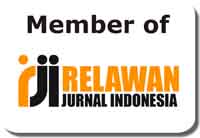Humor, Happiness and Work Relationship among Faculty Members in Islamic Higher Education of Indonesia
Abstract
Humor is important among educators to refresh their mind from busy work, strengthen friendship and interpersonal relationship, create happiness, and to improve working performance and cooperation of both personal and professional matters. This study aims to examine the humor in the perspective of linguistics and psychology, especially the semantic aspect among colleagues of lecturers in Islamic universities of Indonesia. A qualitative-descriptive method was employed to analyze data which were collected through participants’ observation and in-depth interview. The results indicate that to create humor from a linguistic perspective, lecturers used polysemy and homonym aspects as part of the language game. Polysemy is only a word while homonym is a word, abbreviation, and acronym. The words that indicate polysemy is margacinta, hawa, and kopi, while the words that indicate homonyms in the form of words maroko, farj, and tabrakan. On the other hand, the abbreviation homonymy is found in the phrases of peraturan pemerintah and pembimbing akademik and the acronyms are found in words akper, jatol, jaka, marisa and jelita. This language game then creates a joyful atmosphere among lecturers which ultimately affects their interpersonal relationships. The proximity of interpersonal relations also has implications for better employment relations and increased productivity to do works assigned to them. Finally, this research confirms that language games such as polysemy and homonymy can also be used to create humor aimed not only to refresh mind but also to create happiness and improve work performance to increase productivity in universities.
Keywords: Humor, happiness, relationship, lecturer, Islamic Higher Education.
Keywords
Full Text:
PDFReferences
Alavinia, P. (2017). Humor in the Classroom: A Guide for Language Teachers and Educational Researchers, Nancy D. Bell &. Iranian Journal of Language Teaching Research, 5(2), 137-140.
Alifianita, T., Lukmantoro, T., Sos, S., & Si, M. (2016). Language Games in ask. fm Conversations. Interaksi Online, 4(4), 1-11.
Anisah, Z. (2016). Polisemi Pada Wacana Humor Indonesia Lawak Klub. Al Hikmah: Jurnal Studi Keislaman, 6(2).
Andini, I. (2014). Ketaksaan Tindak Tutur Dalam Wacana Humor Pada Acara Sentilan Sentilun Di Metro TV. Bahtera: Jurnal Pendidikan Bahasa dan Sastra, 13(1), 11-19.
Cann, A., & Collette, C. (2014). Sense of humor, stable affect, and psychological well-being. Europe’s Journal of Psychology, 10(3), 464-479.
Carroll, N. (2014). Humour: A very short introduction. OUP Oxford.
Chefneux, G. (2015). Humour at work. Language and Dialogue, 5(3), 381-407.
Dong Yue, X. (2010). Exploration of Chinese humor: Historical review, empirical findings, and critical reflections.
Dyck, K. T., & Holtzman, S. (2013). Understanding humor styles and well-being: The importance of social relationships and gender. Personality and Individual Differences, 55(1), 53-58.
Ford, T. E., McCreight, K. A., & Richardson, K. (2014). Affective style, humor styles and happiness. Europe’s Journal of Psychology, 10(3), 451-463.
Ford, T. E., Lappi, S. K., O’Connor, E. C., & Banos, N. C. (2017). Manipulating humor styles: Engaging in self-enhancing humor reduces state anxiety. Humor, 30(2), 169-191.
Gunawan, F. (2016). The Deviation of Pragmatic Aspects of Lecturer Humor Discourse at IAIN Kendari. Proceedings of International Conference of Linguistics (SETALI): Language analysis from forensic linguistics (pp. 173-178). Bandung: Indonesia University of Education.
Gunawan, F. (2017). Utilizing humor among Teaching Colleagues and its effect on their happiness in Islamic Higher education of Indonesia. Proceedings of The 7th Annual International Conference (AIC) Syiah Kuala University and The 6th International Conference on Multidisciplinary Research (ICMR) in conjunction with the International Conference on Electrical Engineering and Informatics (ICELTICs) (pp. 670-679). Banda Aceh:Syah Kuala University.
Hampes, W. (2016). The relationship between humor styles and forgiveness. Europe's journal of psychology, 12(3), 338.
Holmes, J., & Marra, M. (2002). Having a laugh at work: How humour contributes to workplace culture. Journal of pragmatics, 34(12), 1683-1710.
Kalliny, M., Cruthirds, K. W., & Minor, M. S. (2006). Differences between American, Egyptian and Lebanese humor styles: Implications for international management. International Journal of Cross Cultural Management, 6(1), 121-134.
Kuiper, N. A., Kazarian, S. S., Sine, J., & Bassil, M. (2010). The impact of humor in North American versus Middle East cultures. Europe’s Journal of Psychology, 6(3), 149-173.
Kurtz, L. E., & Algoe, S. B. (2015). Putting laughter in context: Shared laughter as behavioral indicator of relationship well‐being. Personal Relationships, 22(4), 573-590.
Kusno, A. (2014). Permainan Bahasa Pada Humor Cak Lontong (Sebuah Tinjauan Sosiolinguistik). Lingua, 10(2).
Li, J. (2015). Humor in the Hong Kong Language Classroom: Students' Perceptions (Doctoral dissertation, Department of English, The Hong Kong Polytechnic University).
Liu, K. W. (2012). Humor styles, self-esteem and subjective happiness. Humour, 1, 21-41.
Maiolino, N. B., & Kuiper, N. A. (2014). Integrating humor and positive psychology approaches to psychological well-being. Europe’s Journal of Psychology, 10(3), 557-570.
Martin, R. A., Puhlik-Doris, P., Larsen, G., Gray, J., & Weir, K. (2003). Individual differences in uses of humor and their relation to psychological well-being: Development of the Humor Styles Questionnaire. Journal of research in personality, 37(1), 48-75.
Nayyar, R., & Zeeshan, M. (2017). MPhil Scholars’ Views about the Use of Humor in English Language Classroom in Quetta, Balochistan, Pakistan. International Journal of English Linguistics, 7(2), 134.
Ofra Nevo, Ofra, Nevo Baruch, Yin, Janie Leong Siew. (2001). Singaporean humor: A cross-cultural cross-gender comparison. The Journal of General Psychology, 128 (2), pp.143
Porterfield, A. L. (1987). Does sense of humor moderate the impact of life stress on psychological and physical well-being? Journal of Research in Personality, 21, 306-317
Puspitasari, D. A. (2013). Humor dalam kumpulan buku kartun “Benny & Mice” (Suatu Kajian Pragmatik). Suluk Indo, 2(2), 1-15.
Rohmadi, M. (2010). Strategi Penciptaan Humor dengan Pemanfaatan Aspek-aspek Kebahasaan [The Strategy of humor creation with utilizing linguistic Aspects]. Humaniora, 22(3), 285-298.
Stieger, S., Formann, A. K., & Burger, C. (2011). Humor styles and their relationship to explicit and implicit self-esteem. Personality and Individual Differences, 50(5), 747-750.
Thorson, J. A., Powell, F. C., Sarmany-Schuller, I., & Hampes, W. P. (1997). Psychological health and sense humor. Journal of Clinical Psychology, 53 (6), 605-619.
Tümkaya, S. (2006). Faculty Burnout in Relation to Work Environment and Humor as a Coping Strategy. Educational Sciences: Theory & Practice, 6(3).
Usman, B., Silviyanti, T. M., & Marzatillah, M. (2016). The Influence of Teacher’s Competence towards the Motivation of Students in Learning English. Studies in English Language and Education, 3(2), 134-146.
Wijana, I. D. P. (2002). Angka, Bilangan, dan Huruf dalam Permainan Bahasa. Humaniora, 12(3), 271-277.
Wijaya, I Dewa Putu dan Muhammad Rohmadi, Analisis Wacana Pragmatik Kajian Teori dan Analisis .Surakarta: Yuma Pustaka, 2010
Wilujeng, N. C. S. (2013). Language Play: An Overview. Jurnal Kebahasaan dan Kesastraan Multilingual, 2, 215-228.
Wu, J., & Chan, R. (2013). Chinese teachers’ use of humour in coping with stress. International Journal of Psychology, 48(6), 1050-1056.
Yue, X. D., Liu, K. W. Y., Jiang, F., & Hiranandani, N. A. (2014). Humor styles, self-esteem, and subjective happiness. Psychological reports, 115(2), 517-525.
Yuniawan, T. (2005). Teknik Penciptaan Asosiasi Pornografi dalam Wacana Humor Bahasa Indonesia. Jurnal Humaniora, 17(3), 285-292.
DOI: http://dx.doi.org/10.31332/lkw.v4i2.904
Copyright (c) 2018 Fahmi Gunawan

This work is licensed under a Creative Commons Attribution-ShareAlike 4.0 International License.
Langkawi: Journal of The Association for Arabic and English indexed by:



















.png)
.png)

.png)
2.png)








